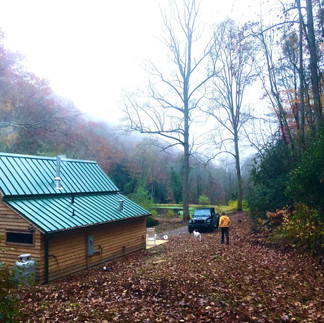The Little Cabin in the Woods - Barn to Cabin Conversion
- Scott Linwell
- Sep 4
- 7 min read
Updated: Nov 15

I love our little cabin. While it’s small, it’s the perfect size for us for now as we formulate plans for this place, including building out a larger (about 1800 SF) post-and-beam stable into a more substantial house. The soaring ceilings - 12’ to the top of the walls and 20’ to the peak of the ceiling make it feel much bigger than it is, and the 500 SF deck around it gives us lots of outdoor living space - and we live both inside and out when we are here.

When we first walked the property here in 2020 I can’t say we paid a lot of attention to the little barn at the “back” of the open areas. We’d been searching for the right piece of land, and that was where our attention was. We’d seen a few places and none had been a real fit.

Our list of “wants” for this place wasn’t unusual, lots of folks looking up here want these things. Water of some sort (river, stream, pond, lakeside), seclusion - this is a getaway after all, meadows or fields for us to create a small farm. We hoped for a small cabin to renovate, or at least a great spot to build one. Barns or outbuildings would be great, but not necessary. You can build about anything you want, but the land is what it is, and that was our priority.

We’d seen quite a few places, and none had what we wanted, really not even close. So when we walked up into this place we were thrilled. It seemed to have it all, more actually than I would have expected in one package and at a price that, to us, didn’t make sense. And there were three solidly built outbuildings and an older, original cabin circa 1940 or 1950 (depends on who you ask).
We loved the open area, the open fields & pond, which add up to about 3 or 4 acres total, all surrounded by another 100 acres of forest. We loved the bold stream, with multiple waterfalls, that flows across the parcel, from top to bottom. We thought there was potential for the older, original, cabin to possibly be renovated and we did like the fact that it has those multiple buildings, including the small barn, but also a larger one and a stable. We just didn’t have definitive plans yet.


Like most projects we work on, landscaping, home renovation, anything with design, we were going to let ourselves become more acquainted with the land, with the grounds, with the feel of the space, before embarking on any large projects. Usually the plans we have at the onset of something new for us change over time. We always allow the spaces, the land, a home, a business space, to speak to us. And we are always listening.
Over the next couple of years, after we closed, we’d travel up once or twice a month, effectively camping in the old cabin. It didn’t have heat. We’d turned on the old oil furnace that first winter, but it kept turning off after running for just a short while.
A local friend who’d helped at the property for various owners over the years brought over someone to take a look. Turned out part of the burning chamber was cracked and it was leaking carbon monoxide into the basement and crawl space. It had been turning off as a safety mechanism. I still remember his answer to my stupid question: “So we can’t use it at night?”
“You can, but not if you want to wake up” he replied.

So we brought up extra blankets and sleeping bags. Plus we had our two big pups Tiki and Wicky at the time, and they were happy enough to curl up close to provide some additional warmth, their creaky old bones eager enough to cozy up.
There was no functioning kitchen, so we used the built-in stone BBQ just outside for all of our cooking needs. We prepped food on the picnic table and we wandered the fields. We had bonfires at night beside the pond, fresh fires from the coals in the morning for coffee, hikes in the afternoons to see what exactly we had up and down the various trails and ridge lines.


Eventually our sights set on the little pole barn set at the far end of the cleared acreage and adjacent to Rush Creek, sitting just above it before it entered, and created, the pond. The views were wonderful, across the open fields and shaded by two giant poplar trees. A new thick concrete slab had been poured by the previous owners, preparing it to be a workshop which never materialized.

At just over 600 SF the cabin doesn’t technically qualify as a tiny home, but in planning for efficiency it effectively is. Really it feels like a large glorified hotel room (with a gourmet kitchen!).



When we designed the space we knew we wanted the large, beautiful, white oak beams to be exposed as much as possible - they are one of the main features that stood out when considering this build out. This barn, and the other two outbuildings, are post-and-beam construction, held together with hand cut joinery and wooden pegs. We actually found an article on newspapers.com which profiled the builder of these little buildings, and uses the stable on our property as the project in the story.
We wanted to use as much as possible from this building, and others on the property, for the build out, especially the rough hewn siding which would be removed, treated, and put back up inside, as the interior walls.
We also rummaged through home good resale shops for other elements - including the two huge church doors Joey found at the Habitat for Humanity ReStore - a couple hundred bucks and they completely set the look of the place, inside and out. They were actually a key component to the build out - taking the place of the large entrance doors it once had, large enough to pull in a tractor.
One advantage of a small space is the ability to use higher end products and still keep a budget. Things like tile, siding, flooring, etc, are sold by the foot, so if there isn’t much of it the cost might be high per unit, but low overall. Same with components like the roof. And windows or doors? We can order custom ones that cost a bit more because we only have a few (one door to enter, three windows).
About a year after closing on this place and camping here we began to draw up plans to create our home in this little barn. Since we’d be building this from afar, in Charlotte, we found a contractor to handle the reconstruction (projects down the road we’ll handle this ourselves since we’ll be here). We pulled permits and began building.

This was during Covid, so the project took some time. If you recall, there were lots of supply chain issues back then, and a few things took quite a while to arrive. We began the project in the spring of 2021, a bit more than year after closing, and finished 16 months later, fall 2022.
It was still another year and a half before we would be able to really call this place home, spending more time here than in Charlotte. Since finishing the cabin we built and installed a kitchen island and shelving system, and built two cabinets (one inside and one under the roof of the covered deck). We don’t really have any new big plans for this place, but we can see the stable across the fields, and are slowly formulating plans for that as well.
It’ll be a fun project, one where we can do much of the construction and build-out ourselves. Especially since we have a workshop right next door - that we built out last year in the other barn. We plan on taking a lot of wood - interior paneling, exterior cedar siding, and any other useful elements - from the old cabin. It was already in rough shape and Hurricane Helene really did a number on it, mudslide from behind dropped trees on the roof, one through the side, and dammed up the spring fed stream behind it, sending the water through the bottom of the home, filling it with mud. At least we don’t have to wonder any longer if we can save it.
UPDATE: CABIN BELOW IS BEING REMOVED BY FEMA - COULDN'T BE SAVED - SEE HERE
Below, the original cabin before and after Hurricane Helene - it was questionable before the storm whether we could save it, she answered for us
barn to cabin Build out at Linwell Falls at Rush Creek, by Joey and Scott Linwell - barn to cabin conversion




































































































Comments